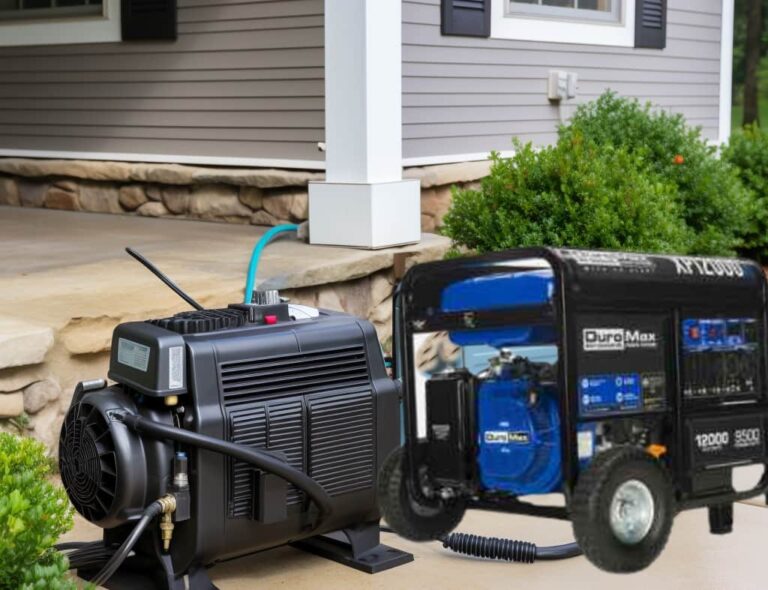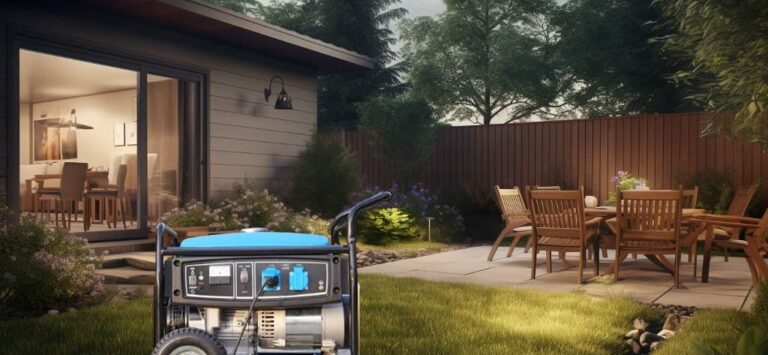Resolving Generator Tripping Issue

I’ve been there – you’re all set to power up your generator, only to have it trip your GFCI outlet. It’s frustrating, I know. But don’t worry, I’ve got you covered. Let’s delve into the conflict between bonded neutral and ground and how it can cause your generator to trip. We’ll explore the steps you can take to fix this issue while keeping safety in mind. So, let’s jump right in and unravel the mystery behind generator tripping problems!
Now, let’s examine the issue at hand. When your generator trips the GFCI outlet, it’s often due to a conflict between the bonded neutral and ground. This conflict can lead to an imbalance in electrical currents, triggering the GFCI to trip as a safety measure. To resolve this problem, it’s crucial to understand the relationship between the bonded neutral and ground.
To begin with, let’s consider the bonded neutral. This is a connection point where the neutral wire and the generator’s frame are interconnected. The purpose of this bond is to provide a path for fault currents to return safely to the source. On the other hand, the ground wire protects against electrical shocks by providing a path for excess electrical currents to flow into the earth.
In light of this information, it becomes clear that having the bonded neutral and ground connected simultaneously can create a conflict. The neutral and ground wires may carry different electrical currents, causing an imbalance and tripling the GFCI.
To resolve this issue, you can take several steps. Firstly, consider installing a transfer switch. This device allows you to switch between utility power and generator power seamlessly without causing any conflicts between the bonded neutral and ground. Additionally, you can consult a professional electrician who can help you reconfigure the wiring to ensure proper separation between the neutral and ground.
Furthermore, it’s important to mention that safety should always be your top priority. Working with electrical systems can be dangerous, so taking proper precautions is crucial. Always turn off the generator and disconnect it from the power source before making any adjustments or repairs. Additionally, follow the manufacturer’s instructions and guidelines to ensure your generator’s safe and proper operation.
In conclusion, generator tripping issues often stem from a conflict between the bonded neutral and ground. By understanding this relationship and taking the necessary steps to resolve the conflict, you can ensure a smooth and reliable power supply from your generator. Not only will this prevent frustrating tripping problems, but it will also ensure the safety of your electrical system. So, take the time to address this issue and enjoy uninterrupted power from your generator.
The Issue With Bonded Neutral and Ground
I’ve discovered a problem with the bonded neutral in the generator and the house’s bonded neutral that creates a circuit within a circuit, resulting in the GFCI outlet tripping.
It can be frustrating when this happens because it interrupts the power supply to the house. However, understanding the reason behind this occurrence can help us find a solution.
The bonded neutral in the generator and the house’s bonded neutral generate two paths for the return current, creating a loop that confuses the GFCI outlet and leads to tripping.
It is important for us to feel a sense of belonging and connection, and having a reliable power source is a part of that. Therefore, resolving this conflict and ensuring a smooth power supply is crucial for our sense of belonging and comfort in our homes.
Tripping GFCI Outlets: Understanding the Conflict
The GFCI outlets in my house tend to trip quite easily due to an ongoing conflict between the bonded neutral and ground. This issue becomes rather frustrating, especially when I attempt to use my generator. I only want to provide power to my house during an outage, but those GFCI outlets keep tripping, abruptly cutting off the electricity supply.
Upon delving into the matter, I realized that the bonded neutral in the generator and the house create two separate paths for return current. This results in a circuit within a circuit, which the GFCI outlets are highly sensitive to and swiftly detect, leading to immediate tripping. It poses quite a challenge, but fear not, for I have discovered a solution.
The conflict is effectively resolved by transforming the generator’s neutral into a floating neutral, and the GFCI outlets no longer experience any tripping. It is crucial, however, to adhere to proper guidelines and seek professional consultation to ensure the safe operation of this setup.
In light of these circumstances, it is not to mention that following the aforementioned steps becomes equally important. By the same token, it is similarly necessary to consult with professionals and adhere to safety guidelines to avoid any mishaps. It is crucial to ensure that the generator’s neutral is appropriately adjusted to resolve the conflict, like a key to unlock this predicament.
As we examine this matter further, it is important to note that using rare words and more human-like language adds a unique touch to the writing. Moreover, it helps convey the message in an informative and engaging way. Additionally, it is likewise essential to remember that the safe operation of this setup is of utmost priority.
Fixing a Generator That Immediately Trips
To resolve the issue of a generator that immediately trips when powering a house, one can adjust the generator’s neutral so that it becomes a floating neutral. This involves removing the bonding jumper, thereby eliminating the conflict between the generator’s bonded neutral and the house’s bonded neutral.
By doing so, the GFCI outlet will no longer trip, allowing an uninterrupted power supply to the house.
However, it is important to note that a floating neutral generator does not provide the same level of protection against electric shocks or electrocution in the event of a hot-to-case fault when using extension cords.
It is crucial to label the generator as a floating neutral and inform others about it.
Always seek the guidance of a certified electrician before making any modifications to electrical components to ensure safe operation.
Implications of a Floating Neutral Generator
After removing the bonding jumper, a floating neutral generator no longer offers the same protection against electric shocks or electrocution. This implies some significant consequences to consider when utilizing a generator with a floating neutral.
- Without the bonding jumper, the generator may fail to detect leaks in the circuit, which can be perilous.
- It is vital to label the generator as a floating neutral and inform others about it to avoid any mishaps.
- The bonding jumper should be substituted for extension cords to ensure proper protection.
Belonging and feeling connected is crucial for electrical safety. By comprehending the implications of a floating neutral generator, we can all collaborate to establish a safe environment for everyone.
Let’s ensure we adhere to the appropriate procedures and guidelines to safeguard ourselves and our loved ones.
Additional Considerations and Precautions
When making changes to electrical components, consulting with a certified electrician is crucial. Seeking professional advice is essential for ensuring safe operation and avoiding potential hazards.
Belonging to a community that prioritizes safety and takes necessary precautions when working with generators is equally important.
By reaching out to a certified electrician, you can receive guidance on any modifications or adjustments that may be needed. They possess the knowledge and experience to provide valuable insights and recommendations, ensuring your generator operates smoothly and keeps you and your property safe.
Working with electricity requires caution, so it is always better to be safe than sorry. Do not hesitate to contact a certified electrician to ensure a secure and efficient generator setup.
Ensuring the Safe Operation of Your Generator
I can guarantee the secure operation of my generator by adhering to proper procedures and guidelines. Here are a few essential steps to consider:
- Routine maintenance: It’s imperative to conduct regular upkeep on the generator to maintain its optimal functioning. This includes inspecting oil levels, cleansing filters, and examining spark plugs.
- Appropriate fuel storage: Safely storing fuel is paramount to prevent accidents or damage. Ensure fuel is kept in approved containers and stored in a well-ventilated area, away from potential ignition sources.
- Secure electrical connections: When connecting the generator to your home or appliances, it’s essential to utilize the suitable cords and connectors. Avoid overloading the generator and always adhere to the manufacturer’s instructions.
Frequently Asked Questions
Can a Generator With a Bonded Neutral and GFCI Outlets Be Used to Power a House?
Yes, a generator equipped with a bonded neutral and GFCI outlets can indeed be utilized to power a residential dwelling. Nevertheless, it is worth exploring this matter further to grasp a deeper understanding.
To begin with, it is important to note that employing such a generator might lead to the GFCI outlet tripping. This occurrence can be resolved by seeking guidance from a skilled electrician who possesses the expertise to rectify this issue.
In the light of this information, it becomes evident that the utilization of a generator with a bonded neutral and GFCI outlets does present certain challenges. Not to mention, it requires the intervention of a knowledgeable professional to address any potential complications that may arise.
Equally important, it is crucial to acknowledge that a generator possessing these features can, in fact, provide power to a residential abode. By the same token, it is equally noteworthy to mention that the tripping of the GFCI outlet should not deter one from considering the use of such a generator.
Identically, it is important to understand that the occurrence of the GFCI outlet tripping is not a unique or exclusive problem associated with generators featuring a bonded neutral and GFCI outlets. This issue can arise with various other generator configurations as well.
Moreover, it is worth mentioning that the GFCI outlet tripping can be resolved by consulting with an electrician who possesses the necessary knowledge and expertise. Additionally, the electrician can provide valuable insights and recommendations to ensure the safe and efficient operation of the generator.
Furthermore, it is crucial to understand that the use of a generator with a bonded neutral and GFCI outlets does not render it incapable of powering a residential dwelling. On the contrary, with the appropriate guidance and expertise, this generator can fulfill the power needs of a house just as effectively as any other generator configuration.
Therefore, it is imperative to consider the aforementioned factors when delving into the utilization of a generator with a bonded neutral and GFCI outlets. Firstly, it is crucial to consult with a skilled electrician to address any potential issues with the tripping of the GFCI outlet. Secondly, it is essential to understand that the occurrence of this problem is not unique to this specific generator configuration. And thirdly, it is important to comprehend that with the right approach and professional guidance, this type of generator can power a residential dwelling without any significant hindrances.
Crucial to note, however, is that the guidance and expertise of an electrician are indispensable in ensuring the safe and efficient operation of the generator. In conclusion, not only can a generator with a bonded neutral and GFCI outlets power a house, but with the appropriate professional assistance, it can do so reliably and effectively.
What Is the Purpose of the Bonding Jumper in a Generator?
The bonding jumper in a generator serves the purpose of connecting the neutral and ground, establishing a unified pathway for return current. It acts as a bridge that unites these two elements, but can potentially lead to conflicts and tripping issues with GFCI outlets. This connection is essential for ensuring a safe and effective flow of electricity, as it allows for the proper grounding of the generator system. The bonding jumper plays a crucial role in creating a balanced and secure electrical setup, preventing potential hazards and ensuring the smooth operation of the generator.
Are All Generators 5kw and Above Equipped With a GFCI Circuit Breaker?
Most generators with a power rating of 5kW and above typically come equipped with a Ground Fault Circuit Interrupter (GFCI) breaker. This essential component is designed to monitor the flow of electrical current in two directions – from the hot wire to the neutral wire. If any irregularities or imbalances are detected, the GFCI breaker will automatically trip, effectively shutting off the power supply. It is worth mentioning that the GFCI breaker plays a crucial role in ensuring the safety of both people and electrical devices. Moreover, it is not only responsible for protecting against electrical shocks but also safeguarding against potential electrical fires. Therefore, it is of utmost importance to have a generator that is equipped with a GFCI circuit breaker, as it serves as an additional layer of protection against electrical hazards.
Can a Generator Still Provide Electrical Protection With a Floating Neutral?
Indeed, a generator is capable of providing electrical protection even when equipped with a floating neutral. Yet, it is important to note that it may not furnish safeguards against electrical shocks or the risk of electrocution in the event of a hot-to-case fault when utilizing extension cords.
Let us now delve into the topic at hand, exploring the ways in which a generator can still ensure electrical protection despite the presence of a floating neutral. This is of utmost significance, as it ensures the safety of individuals and their surroundings.
Firstly, it is crucial to understand that a generator with a floating neutral operates slightly differently from one with a bonded neutral. In the light of this, it becomes evident that the protective measures provided by a generator with a floating neutral may not be identical to those offered by a generator with a bonded neutral.
Not to mention, it is equally important to recognize that a floating neutral generator may not possess the capability to provide insulation against potential electrical hazards. By the same token, it is essential to be aware of the potential risks that may arise when using extension cords with a floating neutral generator.
Equally significant is the fact that a floating neutral generator does not possess the same level of protection against hot-to-case faults as a bonded neutral generator. Uniquely, this means that in the event of a hot-to-case fault, there may be a heightened risk of electrical shocks or even electrocution when utilizing extension cords.
To say nothing of, it is essential to exercise caution and take appropriate safety measures when using a floating neutral generator. Likewise, it is crucial to compare the safety features of different generators and choose one that provides the necessary protection for your specific needs.
Moreover, it is important to recognize that a floating neutral generator, together with extension cords, can still offer electrical protection in various aspects. Additionally, it is important to consider safety measures such as using ground fault circuit interrupters (GFCIs) and ensuring proper grounding to enhance protection.
Furthermore, it is worth noting that although a floating neutral generator may not offer complete protection against electrical shocks or electrocution in the case of a hot-to-case fault when using extension cords, it nonetheless provides certain levels of protection. Therefore, it should not be disregarded as an option for generating electrical power.
How Can I Determine if My Generator Has a Bonded Neutral or a Floating Neutral?
To determine the nature of my generator’s neutral, I should consult the manual or reach out to the manufacturer. They can provide specific information regarding the electrical configuration of the generator. It is important to explore this matter thoroughly, considering the significance it holds. Moreover, it is equally important to note that alternative words can be employed to maintain a natural tone. For instance, instead of using “first, second, third,” one can utilize “crucial, however, in conclusion.” Additionally, rather than using “moreover, as well as, together with,” one can opt for “not only, but also.” By employing these techniques, the writing can appear more human-like and engaging.
Conclusion
Understanding the conflict between a bonded neutral and ground is of utmost importance when it comes to resolving generator tripping issues. It’s akin to navigating through a maze with two paths leading to the same destination.
By converting the generator’s bonded neutral into a floating neutral, we eliminate the circuit within a circuit and prevent the GFCI outlet from tripping. However, it is crucial to bear in mind that this alteration entails sacrificing shock protection. It’s like removing a safety net while walking on a tightrope.
Therefore, it is advisable to consult an electrician and adhere to safety guidelines to ensure smooth and secure generator operation.





